Smyth A16 Realiser Headstand DAC / AMP – 3D Stage For Everyone
Smyth A16 Realiser is a really unique product that deserves a longer and more complex review than my typical takes. It is priced at around 4000 USD at the moment of writing this full review, it is basically a DAC / AMP / DSP processor for 3D sound. It has features for head tracking, two headphones outputs, can measure headphones, works as an EQ, and has many other features that we’ll be exploring in today’s review. The main comparisons will be with traditional DAC/AMPs and setups, like the Mytek Brooklyn DAC+, Analog Audio AAdac, and M2Tech Young MKIII powered by a Wells Milo Amplifier. I will also be pairing the A16 with Audeze LCD-MX4, Kennerton Thror, and Rosson RAD-0.
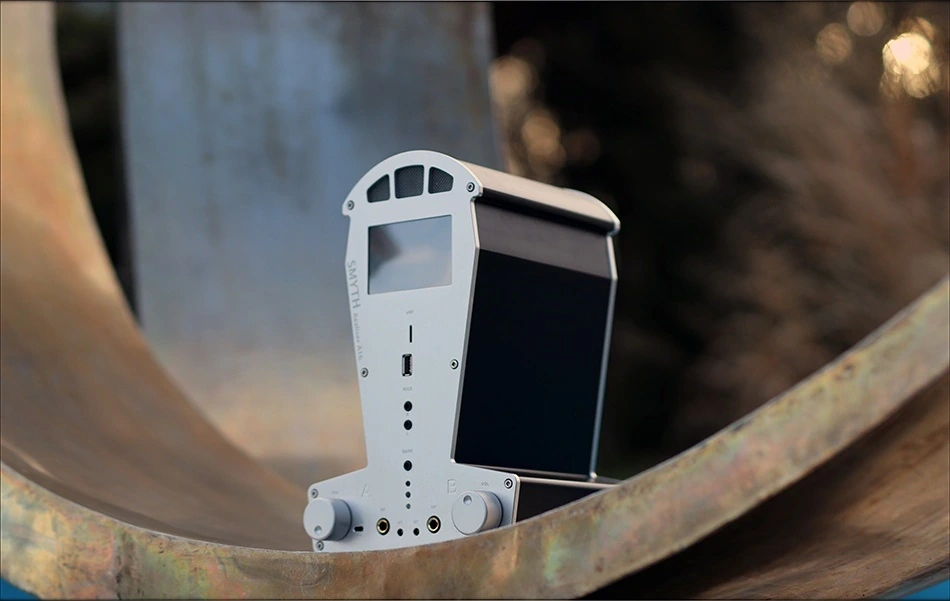
Introduction
A16 has a pretty complicated and long history with an entire cult following it, and being quite faithful to it. It has been launched in multiple revisions, with improvements along the way, and the one we’re reviewing today is the best, latest variant, which does not really have an official price, but is quoted at a MSRP of 4000 USD online, in multiple locations. You should not confuse the price it is being sold at with the production price, because as some people pointed, it does not have uranium inside, but for a small start-up company to write an entire 3D processor that is this complex and actually works in real time, is a real achievement. A big thing with 3D and DSP in general is that they need to still be processed in real-time. Regardless of how well you make software, Windows has a bad habit of not processing things fast enough. This is why most advanced software that allows for complex EQ schemes and DSP and 3D processing does this in many seconds of work, and is used for mastering. That ain’t good enough if you want some real-time improvements of your listening experience, and this is the biggest thing of today. You should keep in mind that even if A16 is an outstanding standalone unit, it has RCA outputs and can use an external headphone amplifier, or even be connected to a Stereo setup, so its usage is far wider than I can cover in a single review (which is already pretty long). A16 features DTS, Dolby, Dolby Atmos, Dolby Surround, and is licenced by Illusonic and Auro Technologies. The company, Smyth Research LTD is from northern Ireland.
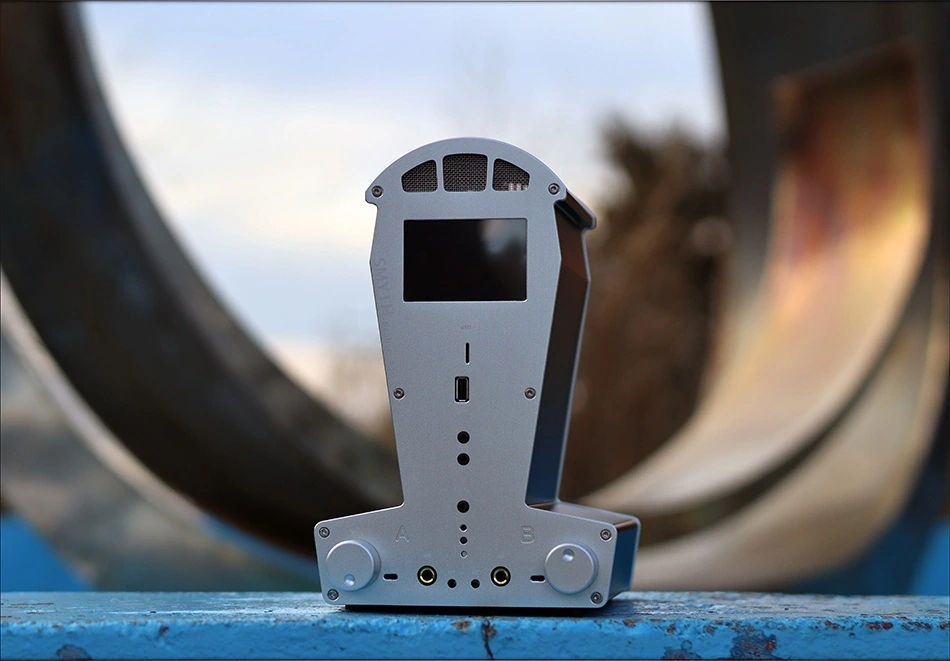
It should be noted that I have absolutely no affiliation with Smyth. I’d like to thank Smyth Audio for providing the sample for this review. This review reflects my personal experience with the Smyth A16 Realiser. Every opinion expressed is mine and I stand by it, the purpose of this review is to help those interested in Smyth A16 Realiser find their next music companion.
Product Link
You can grab a Smyth A16 Headstand Unit from the official website here: https://smyth-research.com/product/a16-headstand/
You can grab one from www.amazon.com here: https://amzn.to/3Ua3QXx
Packaging
The package of A16 is far more complex than our typical DAC/AMP and review unit. This being said, I made an entire video about setting it up, and while all the accessories are necessary, it can feel overbearing at time. It was clearly used a lot with a Stax system and a HD800, so folks there are used to really long cables, and are really careful about the quality of everything inside the package.
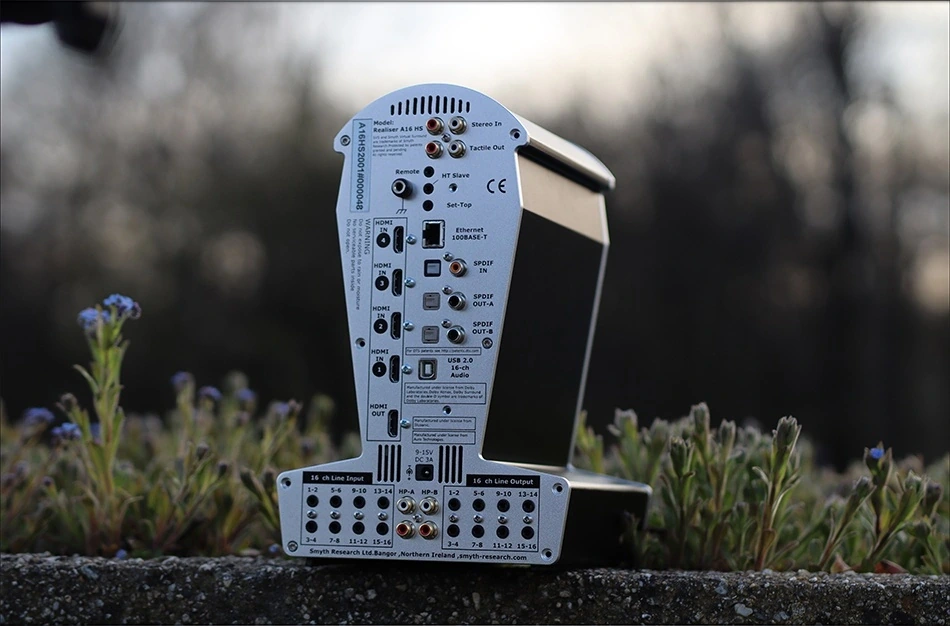
All cables that come with A16 are slightly tangle prone, and thin, also extremely long. This is excellent because you can measure not only headphones, but also rooms, and you will need all that length to fully take advantage of it.
Inside the package, you can find the following:
- Two microphones
- One Extension Cable
- Head Tracking Unit
- Head Tracking Sensor
- Power Deliver Unit (PSU)
- Remote
- Clips
- Rubber bands
- Foam tips
- Accessories to attach the tracking units and to hold the cables
- The A16 Unit itself
We’re looking at a hefty price, but the package is really extra and covers every usage scenario we can think of, making A16 pretty much the best overall DAC/AMP in terms of the package and how well accessorized it is.
This being said, if you’re coming from a stereo background and are used to hefty metallic remotes, or ornamental features, there are very few here. There is a clear emphasis on usage above looks, and if something breaks from the package you will need to order a replacement from Smyth directly, as I never seen any of the extras being sold outside of the shop from the company.
Build Quality / Aesthetics
The unit looks like a headphone stand, which is probably why it was named the Smyth A16 headstand too. The unit has a huge number of inputs and outputs and makes what is the most complex and advanced device I reviewed on Audiophile-Heaven so far. To start, we have the unit acting as a headphone DAC / Amplifier. This is because to take full advantage of the unit, you need a pair of midrange or high-end headphones, which you will then measure and use with the A16.
Starting from the top to the bottom, we have grilles for the unit’s venting, and so it won’t get hot. There’s quite a bit of processing going on inside, and I honestly never felt it going too hot, which is pretty good, considering that heat reduces the life of electronics. There’s a large display, which has good viewing angles. The colors of that display won’t be important as most of the time it is showing a white text on a black background.
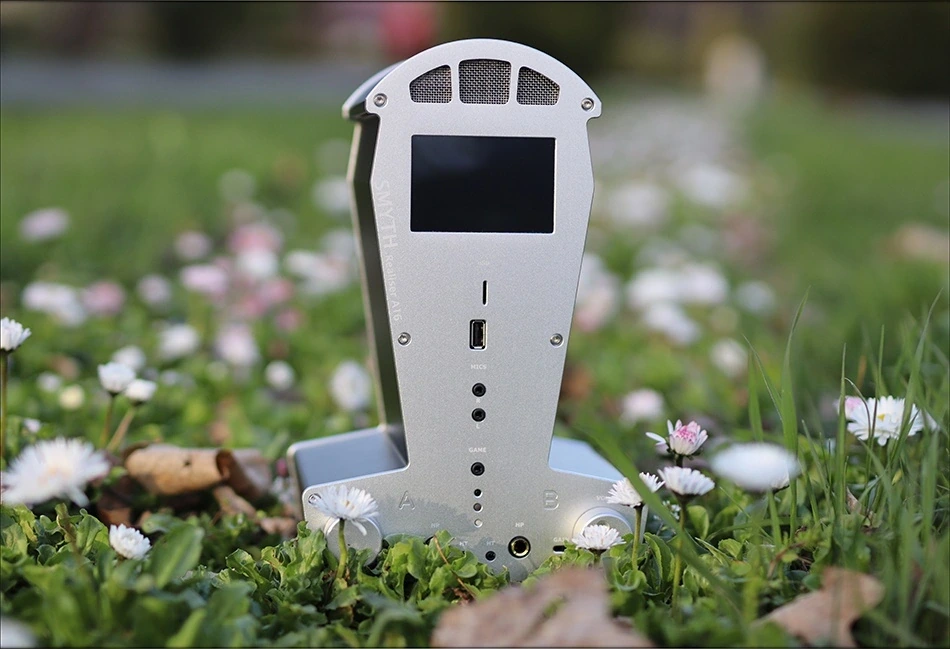
There’s a microSD slot, a USB slot, and two microphone inputs. You should keep in mind that there is a vertical variant around, the one we are reviewing right now, but also a horizontal one, that doesn’t have the same layout. The vertical one has a bit more personality, while the flat one looks more classy and would blend better with your collection of audio-related electronics (amplifiers in particular, since A16 has its own DAC inside).
There are two headphone outputs, each with its own gain and volume control. There are also two head tracker inputs, as that is what HT stands for, but there is only one head tracker unit included in the package. Every component is unique and tailored for A16, so if you’re looking for any extras or replacements, you mainly will have to purchase from Smyth directly. This is important to keep in mind, because the company offers excellent support and is quite friendly, plus it doesn’t look like they’ll be going away any time, rather investing their all in their products. As seen on Head-Fi, Smyth stated that they sold sold the A16 at a price that doesn’t reflect even their own production price during the Kickstarter campaign, but they are still honoring all those sales, and combining them with new sales, to be able to support financially. This is quite excellent, as most companies typically give up on a Kickstarter campaign once it fails.
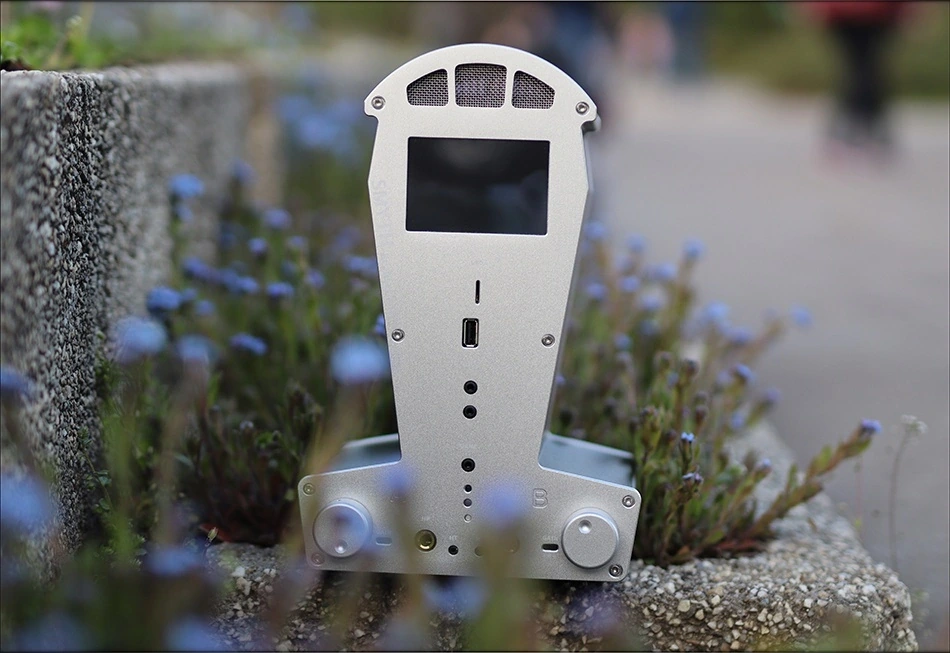
The back of the A16 is actually the most complicated part of it, as we have, from top to bottom, RCA stereo inputs, and Tactila outputs. We have a home theater slave, which is basically the sensor, and we have a port for the grounding bracelet. There are 4 HDMI inputs, and one HDMI output, and there are Ethernet, SPDIF and USB inputs too. There is one SPDIF Digital output too. The unit takes in 15V at 3 A needing little power for a unit this complex and with such a high quality headphone amplifier inside. There is a Headphone RCA output for each A and B headphone ports, which is perfect for having an external amplifier powering the headphones. And the one feature I still can’t quite understand or get my head around, we have a 16 channel input and a 16 channel output. Basically, you can set this up as your all in one Home Theater processing solution.
As I noted earlier, the cables are quite long, and the unit is visibly ready for any setup you may have, although this means that once you start playing with it, the whole setup can get a bit messy. Especially if you don’t know what you’re doing, you could get lost in the mess, and following the compilation and tutorial videos by Smyth is a great idea to keep up with what you’re doing.
You can install the head tracker unit on multiple headphones, but I really recommend one that has a metallic or solid frame, as when installing it on the HIFIMAN HE400i 2020, I noticed that the rubber bands really were too tight for the thick headband and would cut into it after a longer period of time. That tracker needs to stay upright and fixed, so it is great that the mechanism works though.
The remote is perfect for the unit, although the buttons are rubbery and can take 10-15 minutes to browse through the entire feature setup and usage scenario. The unit is built really well and solid, and despite the rubber / foam feet at the bottom getting displaced on my unit, because it has been in a backpack, and because it has been outdoors, which is not expected for any unit, I noticed no damage at all after my abuse. All in all, I’m really happy with the build quality of every component from the A16, but do consider it takes a more advanced and patient user to fully take advantage of it.
Software / Usage
The usage of the A16 seems really complicated at first, and can take a while to understand. Once again, I did my best to make a video highlighting how easy and quick it can be to pair A16 with a new headphone and use it. You need to keep in mind just that you will need to use the two microphones, you will need to be really careful, and you need to re-measure every headphone. Every software reinstall will erase the old profiles, unless you save them to a microSD card. Since there has been no new firmware released since I got it, I have not experienced this side effect thus far.
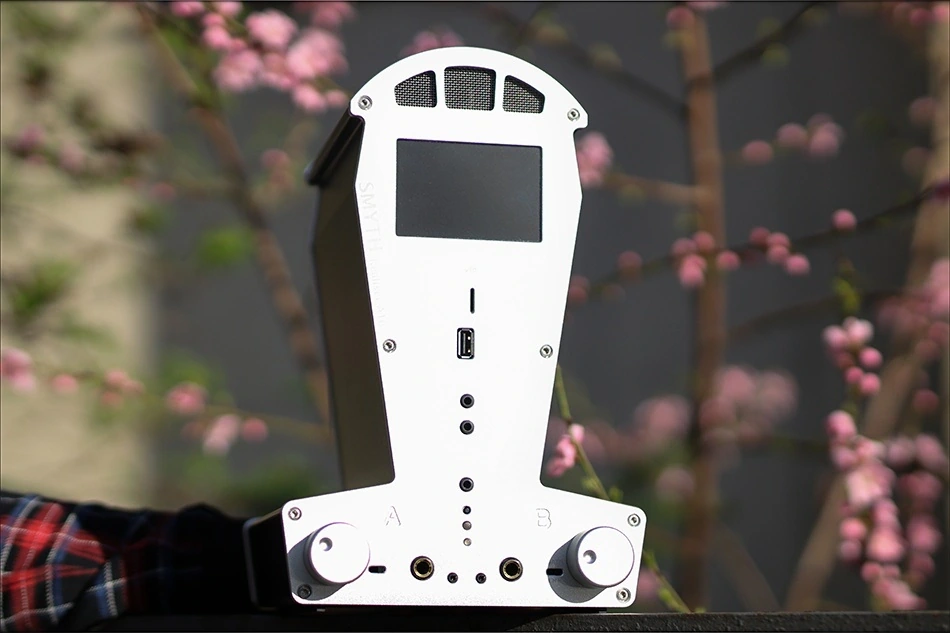
Measuring a new pair of headphones takes less than a minute, and installing everything takes between one and five minutes. Make sure to wear the anti static bracelet to not damage the really sensitive microphones. Using both closed back and open back headphones seems to work just fine in my experience, as I tried the A16 Headstand with HIFIMAN Sundara, HIFIMAN Arya, HIFIMAN HE6SE, Audeze LCD-MX4, Ultrasone Signature DXP, Mr. Speakers Aeon Flow, Crosszone CZ-1 and Beyerdynamic Amiron.
I also dipped a bit into testing the A16 with external Amplifiers, with Feliks Echo, and Audio-GD Master 19, but honestly and realistically, it sounded really great as it is, as a standalone unit. The price would have dictated this, and I really was hoping it would, but the actual size / weight / power consumption did not dictate it would be able to be this awesome at driving headphones.
The setup becomes more complex once you go beyond setting up custom headphone profiles, as you can take room measurements, and improve even more, but at that point I realised I was a bit in over my own head, and could already take sonic impressions about the A16 Headstand, so I proceeded to the sound quality part of the review.
Sound Quality
I want to start by saying that I took the time to play with the head tracking mechanism, as well as most of the functions on the A16 before writing the sound quality part of the review. I have paired it with many headphones, including pretty narrow or limited sounding ones, like Sennheiser HD660S, HIFIMAN HE400i 2020, Rosson RAD-0, and even Verum One. Then, I also test the A16 with wide-sounding headphones, like HIFIMAN Arya, Crosszone CZ-1, Kennerton Thror. Regardless whether you’re using closed-back headphones or open-back headphones, A16 works perfectly. At least in my experience, it does work with both hard to drive planar magnetic headphones, and with high-impedance Dynamic Driver headphones. It is designed, tested, and produced using Sennheiser HD800S as the headphone for tests and development. The company is also known for using Stax systems when producing and designing the A16, and they quited that Stax has a great soundstage, although in my limited experience, while producing a really natural sound, that can get addictive, Stax systems never have a wide stage like Hd800S, nor the control of the hard to drive planars, especially in the bass. This may explain some of the things I noticed with A16 and when pairing it with headphones that distort a bit in the bass, like HIFIMAN Sundara.
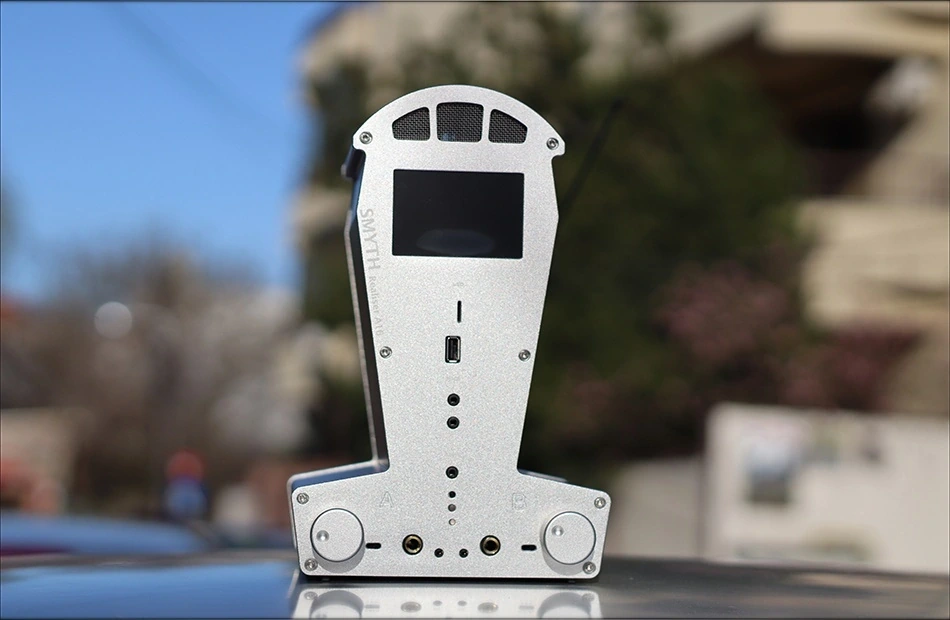
Smyth A16 follows a unique response curve, and applies an EQ to every headphone out there, trying to even them out and give them a more natural sound. You could use it with the default profile that is made for HD800S, but the performance won’t be outstanding that way. Measuring every headphone will result in a very specific result, and in my honest personal experience, the best part has been that the curve it goes for is actually presented more like a live sound than a studio one. A16 does its best to give every headphone the most performance it can, provide the deepest, most rumbly yet natural bass it can, most colorful and detailed, wide and clean midrange, and a sparkly, clean top end, all while providing a dynamic range that’s better than any Top Of The Line DAC I tested to date.
Starting with the bass, this has been one of the biggest surprises I’ve had this year. To start, I am a bass enthusiast, and I appreciate a deep and impactful bass. But I am really sensitive to bass distortions, and a lot of headphones can distort when listening to bass-heavy tracks. Usually IEMs do a little better in this department, as stuff like IMR Opus Mia, FiiO FD5, and Final Audio A8000 can keep a really good control of the bass with zero distortions. Headphones with a really good clean bass can be both planars and dynamics, like Rosson RAD-0, but planar magnetic headphones usually have a meatier and more impactful low end than their dynamic counterparts. The thing with A16 is that it managed to absolutely transform the bass of every headphone I tested with. For example, with HIFIMAN sundara, which is an ok entry-midrange headphone, it managed to give them the bass of Arya, without breaking a sweat. I tried to replicate this with EQ, but nothing I did could ever come close to how controlled, articulate and clean the bass of Sundara is with A16, and how nicely it can extend in the sub lows. Exactly as described in their brochures and website, it creates the feeling of a real multi-speaker setup, with a real, life size subwoofer, inside your headphones.
With better headphones, things get even better, as Rosson RAD-0 became more controlled and had more detailed in the bass, without loosing its visceral impact, and HIFIMAN Arya, which was always pleasing in the lows, gained a better sub-lows presentation with a more visceral sub-bass impact, yet keeping their detailed and natural presentation, with the warmer midrange.
You should keep in mind that the differences I’m talking about here are way larger than the ones you typically hear when switching the DAC or the Amplifier. A16’s processing transforms a headphone into almost a new one and their DSPs are considerably more aggressive than anything I experienced to date. We’re looking at differences of 8-12dB rather than the typical 1-5 dB of differences. A16 can also change the character of a headphone, not only the frequency response, and where needed it can speed up the bass, tighten it, and increase the overall blow / impact all while removing distortion that a headphone would show with any other source.
Usually, devices that apply such a DSP fail miserably, and I only very rarely had heard anything that was even remotely decent while trying to go for a multi-channel setup. Even better, the default EQ A16 is trying to go for is actually achieved.
The midrange seems to be similar regardless of the headphone connected, and while with the bass, it did have different results, the midrange always became extremely wide, well separated, and somewhat warm. A16 is never clinical nor neutral in the real sense of the word, rather going for a natural, smoother presentation. Detail is still excellent, and every time I did the measurements I could notice a slight dip in the mids, which both helped increase the soundstage perception, and also created a slight void in the midrange. This works really well with large sounding music, like Classical, Jazz, Pop, EDM, Dubstep. It works less well with Punk, Death Metal, and Deathcore, where it spreads the music a bit too wide and too far. It is good to know that the instrument separation is quite excellent, so as long as you like a wide presentation, it will work perfectly.
The treble is generally sparkly and uplifted, and this was a huge thing with headphones like Rosson RAD-0, where the default treble is smoother and less energetic, and I was quite concerned that they may become strident. After the A16 EQ and treatment, I noticed that every headphone presented a sparkly, yet non-sibilant treble. The extension is always really good, and it doesn’t extend on the headphone extension itself. A brighter, more sparkly headphone will have more air and a stronger treble, with better extension. It is interesting that while the A16 can easily dominate the bass character and transform a headphone from a simple distortion-prone headphone to a true bass cannon, it doesn’t play so much with the treble. This may be a slight limitation of microphones in general, although I was expecting the bass to be much harder to tackle with such small microphones. It’s quite possible that Smyth played the safe route with A16, as to avoid dangerous and fatiguing treble spikes on headphones that can’t produce them without distortions, since treble distortions are slightly harder to tame via DSP.
Comparisons
Since I have not yet reviewed many other DAC/AMPs that have the same processing powers as A16, the comparisons part will be a bit unfair, but there are DAC/AMPs that cost less than A16, and which weight in more, are more popular, and which are build with arguable different and more desirable features, like XLR Balanced outputs and such.
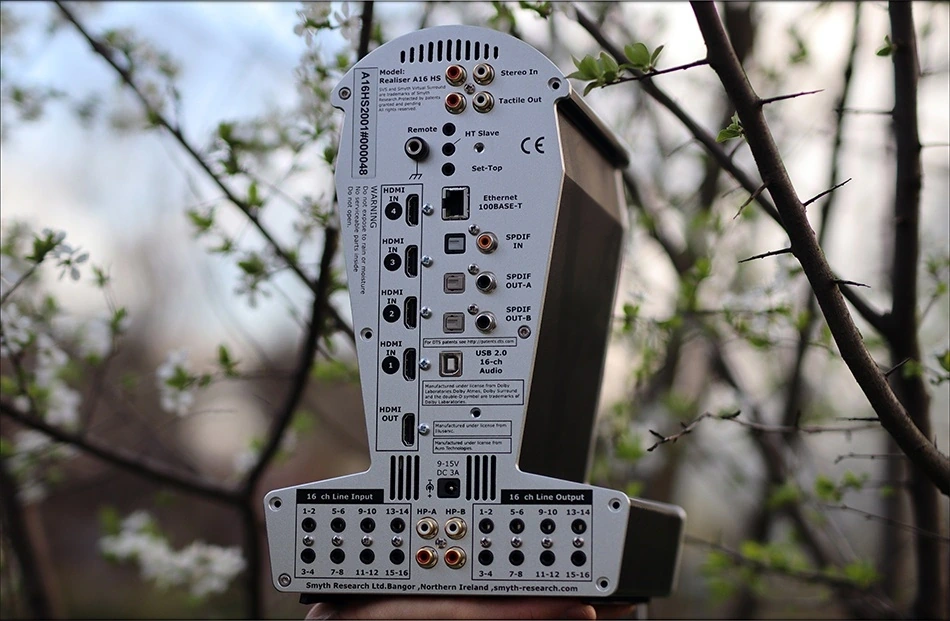
I Selected the Mytek Brooklyn DAC+, the Analog Audio AAdac, and the M2Tech Young MKII + Wells Milo to compare to A16 and its output. For A16, all headphones have been measured with its own microphones, and I applied the resulting EQ profile, but that is absolutely everything I did, everything else being left at default. This was to keep the process as impartial as possible.
Smyth A16 Realiser Headstand vs Mytek Brooklyn DAC+ (4000 USD vs 2500 USD) – The thing about the Mytek Brooklyn DAC+ is that it has a really good driving and amplification stage, but also works nicely as a DAC for full sized systems. I liked the overall operation and sound of the DAC+ a lot when I reviewed it, and I figured it is a good moment to let something replace it in the list, but I was not quite sure about A16 at first. The overall performance as a DAC and as an AMP of the A16 will never be as consistent as that of the DAC+, and that is important to keep in mind. DAC+ will sound great regardless of how you configure it, but A16 really needs to be configured with an EQ profile, and I couldn’t get to a default baseline performance yet, so if you’re into getting the best performance out there, A16 can provide a much wider soundstage, much better instrument separation, better overall resolution and detail. But this comes at the price of having to configure it, measure, and spend a few minutes. It can be done in 5 minutes, but it is a hassle you’ll have to go through. You also have to learn a bit about what you’re doing, but I feel that’s the best part about A16, being able to fine tune your experience to improve on your music listening experience.
Smyth A16 Realiser Headstand vs Analog Audio AAdac (4000 USD vs 4000 USD) – Here, the price is the same, so both should perform exactly the same, but they actually perform radically different. AAdac is much larger, has a much better build quality, more serious look, much better circuits, with larger more copious capacitors, and generally a design that can make one jump in excitement about the sound. The actual sound of the two is exactly the other way around from how they look. AAdac is really nimble, quick, dynamic and uplifting, with the bass being closer to neutral, while A16 is really powerful and authoritative, despite its smaller size. It is easier to use headphones with the AAdac, and I know IEMs work too, since I’ve used a few, while with A16, you need to use mainly headphones, but you can squeeze a considerably larger soundstage with even better instrument separation. A16 generally can do better stage and instrument separation than anything, ounce you measure and apply the proper settings to a headphone, including DAC/AMPs that cost its own price, and those that are really well-established ones.
Smyth A16 Realiser Headstand vs M2Tech Young MKIII + Wells Milo (4000 USD vs 1500 USD + 2000 USD) – When having a really complex setup like this, I expected that A16 would lose some ground, and that I would be able to prove that simple stereo setups are better, but I still scratch my head as I have to admit that A16 does a better job in the soundstage, instrument separation, and overall naturalness. That’s right, even with the magic approach of Milo and the solid detailing / staging of Young MKIII, A16 still manages to perform better in staging, instrument separation, bass control, authority and overall impact.
Pairing
For the pairing part of today’s review, I selected the Rosson RAD-0, Audeze LCD-MX4 and Kennerton Thror. Those are the headphones I spent the most time with together with the A16, and the ones where I noticed the biggest improvements while using it.
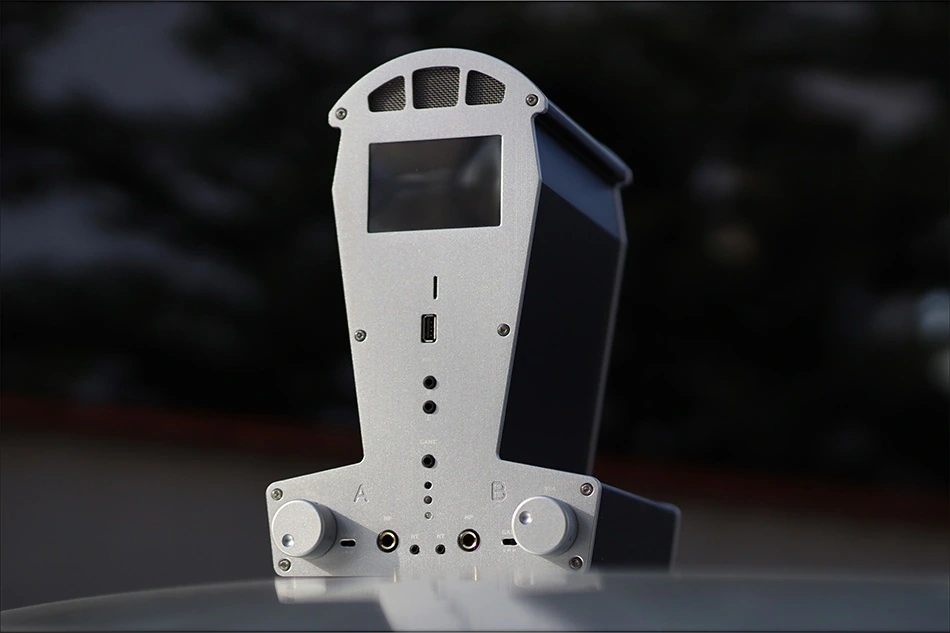
Smyth A16 Realiser Headstand + Kennerton Thror – (4000 USD + 3000 USD) – Neutral it is with Kennerton, and most of their headphones are really neutral in tuning, with almost zero coloring and with very little deviation from an absolute neutral presentation. A16 does one of the most wondrous jobs here, increasing the bass size considerably, but also toning the treble of the Thror a bit, giving them a much more enjoyable sound in the long run. Everything follows the Harman Curve much closer, with the bass being more impactful, deeper and larger in quantity. The midrange is considerably more spacious, more open and has better overall separation / clarity. The treble stays pretty much the same, with some peaks feeling smoother, and some of the hotness in the treble being smoother and better handled.
Smyth A16 Realiser Headstand + Rosson RAD-0 – (4000 USD + 2200 USD) – If you love a smooth and really liquid headphone, RAD-0 it is, with no reserve. I am happy I did this test, because while with some Audeze Models the sound could be dry at times, with RAD-0 the sound is always just right. The only thing I ever wanted to change about RAD-0 was the treble, and even there I would only add a few dB especially in the upper treble to make the sound more to my liking, and closer to the Harman Curve. A16 actually does not do any of the things I wanted, rather changing the signature of RAD-0 entirely, making them a bit lighter, more snappy, and more detailed in the midrange. The treble is generally increased a bit, but the biggest surprise was in the soundstage, which was always rather intimate with RAD-0. Regardless of how much EQ I ever applied to them, I could never get even remotely close to the soundscape that A16 is able to paint together with RAD-0, while also improving on their overall instrument separation.
Smyth A16 Realiser Headstand + Audeze LCD-MX4 – (4000 USD + 3000 USD) – One headphone you want driven well is LCD-MX4. This is one of those headphones where the bass was already enough, and most of the issues lied in the midrange and the treble, where MX4 can be a bit too smooth and lean at times, but also too dry in the bass, that is revealing and detailed, but not the most liquid one out there. A16 brings LCD-MX4 to a whole new level actually making them sound wide, spacious and clean, with a much more natural bass presentation, a more natural midrange, solving most of the dips there, somehow improving on the dynamics and the overall resolution too. The treble is also increased a bit, making LCD-MX4 more enjoyable and engaging.
Value and Conclusion
At the end of the day, the value of the A16 is actually not that bad. It is a high-end DAC/AMP/Processor, and as much of a proof of concept device, as it is a novel flagship unit with an entirely new function. It serves more purpose than most high-end DAC/AMPs, at a smaller size, but it is also more refined than anyone would’ve expected. Despite the name Smyth maybe not ringing a bell, they are a proper brand with a long story behind, and they have actual support, opposed from no-name chinese brands that may stop existing and offering warranty tomorrow. I’m not talking about well-established companies from China like FiiO, iBasso, Shanling or Audio-GD, who are going to be around for at least another ten years. There are new companies, especially those that make less reliable products (check out my video and comments on Topping L30, and my video about Loxjie D10).
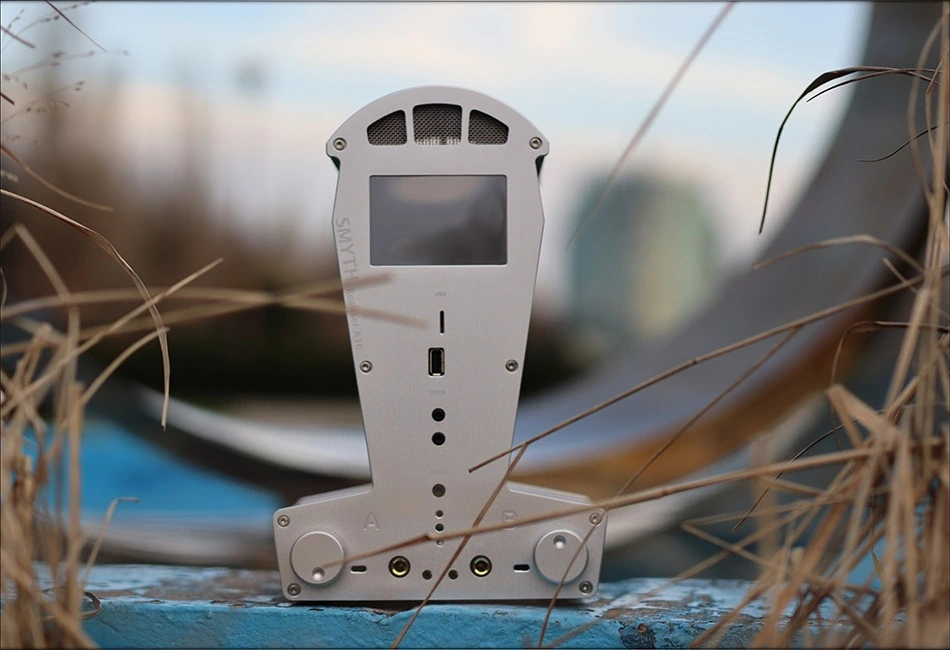
Smyth is a proper English company with good support, so you can expect them not only to be around, but to be able to help repair, fix, support, upgrade your A16 along the way. I am really hoping that they will keep improving and releasing more newer DAC/AMPs / processors that really make our music experience better. Before we know it, it may become feasible to see smaller, yet easier to produce units that will turn the audio-world for an even more fun experience.
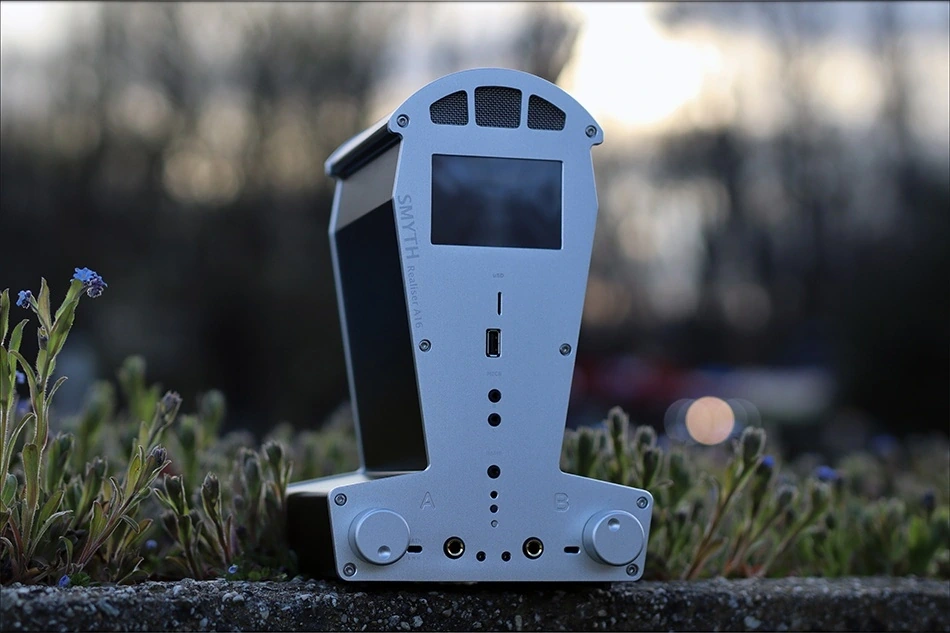
For those of us who want to help support evolution and expansion, supporting the company now and getting their flagship now will surely help the future, and please always remember that for products like the A16 Realiser, you’re paying for the entire package and experience. It comes with a ton of extras, and with the know-how to improve your music experience and turn any headphone, regardless of the price, into a mini home theater. We’re talking about a proper HT which has the price of the subwoofer usually higher than the whole A16 Realiser unit alone.
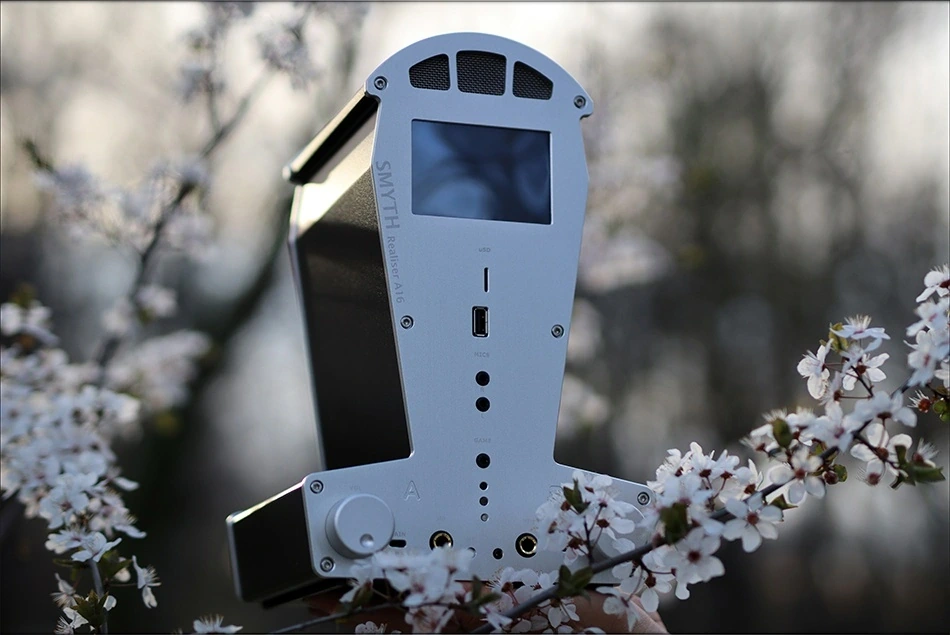
Before the end of today’s review, I want to add Smyth A16 to Audiophile-Heaven’s Hall Of Fame, for being one of the most interesting DSP processor / DAC / AMPs I ever heard, and am really curious to see what’s the next best thing that Smyth will come with. I will also keep conducting experiments with it and pairing it with headphones, so please check out my future reviews, and the Youtube Channel to see and hear more about music!
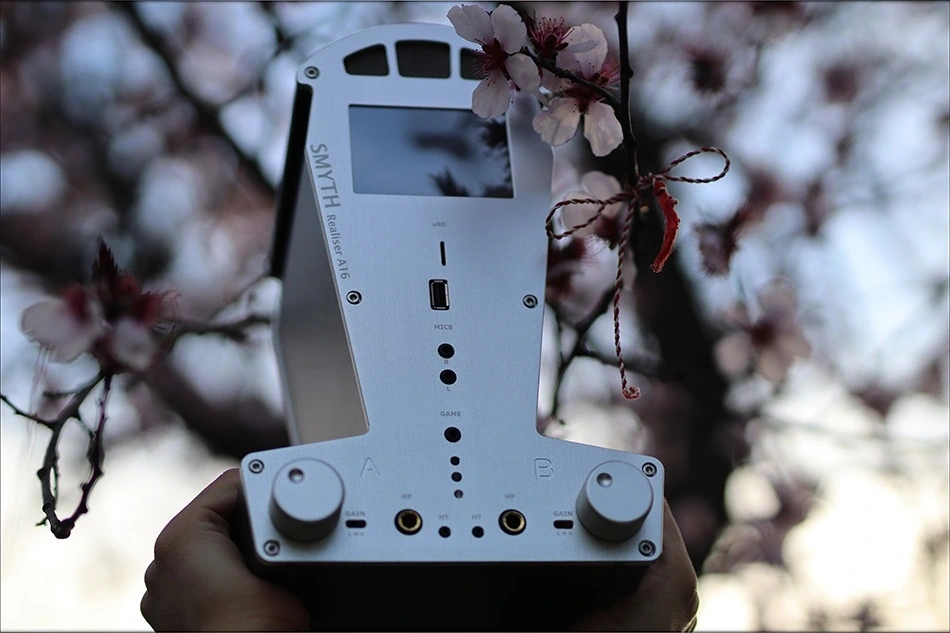
At the end of today’s review, if you’re looking for one of the best DSP processors that can listen to your headphone, and actually EQ it automatically, provide a true home theather like experience, or something to just explore and explode the soundstage that’s hidden in your cans, the Smyth A16 Realiser is surely the best I tested thus far, and not only works, but does a really good job at both staging and bass.
Product Link
You can grab a Smyth A16 Headstand Unit from the official website here: https://smyth-research.com/product/a16-headstand
--- Please remember to stay safe, and always have fun while listening to music!---
- If you have a dime to spare, please donate, and help us! It would make the day brighter for me and my wife-
Full Playlist used for this review
We listened to more songs than those named in this playlist, but those are excellent for identifying a sonic signature. I recommend trying most of the songs from this playlist, especially if you’re searching for new music! The playlists are different for Spotify, Tidal and Youtube, and based on the songs I enjoy and are available on each!
https://www.youtube.com/playlist?list=PL_cjBXGmwSHSdGcwuc_bKbBDGHL4QvYBu
https://open.spotify.com/playlist/5J3oloz8Riy9LxEGenOjQ0?si=979ba4f082414be7
https://tidal.com/browse/playlist/330fd544-8e5b-4839-bd35-676b2edbb3d5
--- Contact Us ---






[…] Amplifiers today, and putting it to the test against the AMPs in the best alternatives, including Smyth A16 Realiser (4000 USD), Analog Audio AAdac (4000 USD), iBasso DX320 MAX Ti (3499 USD), Feliks Euforia (2000 […]
[…] before. Given its price point, we will compare it to the best of the best sonic sources, including Smyth A16 Realiser (4000 USD), Analog Audio AAdac (4000 USD), iBasso DX320 MAX Ti (3499 USD), Astell & Kern […]
I am glad you enjoyed your unit. My story is totally different. I paid online for a unit and never received my unit. At first, Smyth said it was delayed and they would deliver. But now, 3+ years passed by, and they no longer respond to my emails
I’m really sorry to hear about that, friend! Somewhere in the lines, they stopped answering communication with me as well, maybe the business ran cold. . .
Super nicely written review, thanks a lot for all your effort!
Really awesome review, George! Been following you for years, and you’ve been improving ever since!
This review actually convinced me to get one of those A16 DSP processors, as soon as I can save enough money
I love seeing your photos with all that nature and audio gear in there! Best reviews website with the best stuff, i really dislike all those photos on white background with nothing but the product to be honest.
Also, loving the review, I may order one myself. Still trying to see where I can get one, but I think I will just contact the guys via mail